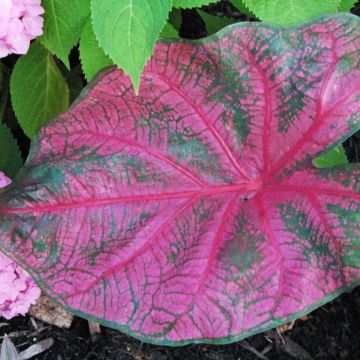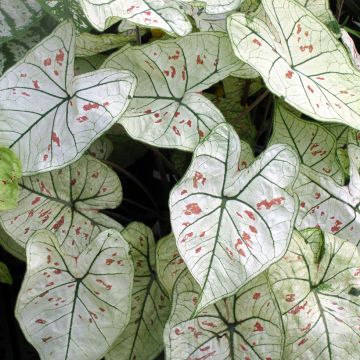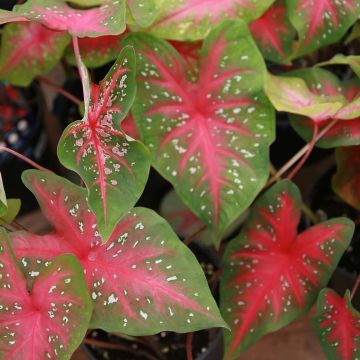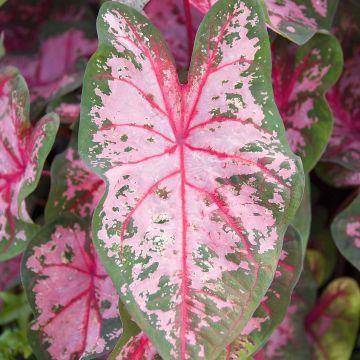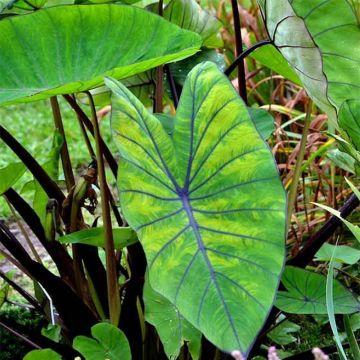

Caladium Rosebud - Angel Wings
Caladium Rosebud - Angel Wings
Caladium x hortulanum Rosebud
Angel Wings, Heart of Jesus, Elephant Ear
This item cannot be shipped to the selected country
Delivery charge from €5.90
More information
Delivery charge from €5.90
More information
Schedule delivery date,
and select date in basket
This plant carries a 6 months recovery warranty
More information
We guarantee the quality of our plants for a full growing cycle, and will replace at our expense any plant that fails to recover under normal climatic and planting conditions.
From €5.90 for pickup delivery and €6.90 for home delivery
Express home delivery from €8.90.
Does this plant fit my garden?
Set up your Plantfit profile →
Description
Caladium 'Rosebud' is an original and brilliantly coloured variety that tolerates the sun better than light-colored foliage varieties. Its large leaves, a beautiful bright green, display a large central macule and veins of bright pink, with a white halo separating the two colours. A tuberous plant highly appreciated in the 19th century for bringing an exotic touch to elegant interiors, Caladium is making a comeback in pots, as well as in ephemeral flower beds where its large heart-shaped, harlequin-patterned leaves always make a big impression. Native to tropical America, Caladiums are tender shade plants that are grown as annuals in the garden, or in pots indoors, in a conservatory or greenhouse. The tubers should be stored dry and cool in winter.
The genus Caladium belongs to the Araceae family and includes about 12 species native to Brazil and adjacent regions of Central and South America. In common parlance, they are called elephant ears, heart of Jesus, and angel wings because of the shape of their large leaves. In nature, these tuberous plants grow in clearings and on the banks of watercourses. They are in vegetation during the rainy season but enter dormancy to escape the dry season. It should be noted that all parts of the plant are toxic to humans.
Caladium 'Rosebud' hybrid forms a clump of leaves measuring approximately 50-60cm (20-24in) in all directions from spring onwards. The leaves, which measure approximately 35cm (14in) in length and 20cm (8in) in width, have a characteristic elongated and notched heart shape with a pointed tip. When it occurs, the flowering is quite insignificant. It takes the form of a yellowish spathe or cone surrounding a column called a spadix, characteristic of plants in the arum family. In early autumn, watering should be reduced. The foliage dries up, indicating that the plant is entering a period of rest. This is the time to dig up the tubers, which will spend the winter in slightly damp turf, in the shade, in a cool room maintained at 16 or 18°C (60.8 or 64.4°F).
Caladium 'Rosebud' will bring a very exotic touch to partially shaded flower beds throughout the summer, and its particularly colourful foliage will enhance all neighbouring plants. Place it, for example, at the foot of hydrangeas, Japanese azaleas, or dwarf rhododendrons, or create a beautiful scene with Impatiens, hostas, and lobelias that appreciate the same woodland environments. Also, create gorgeous flowering pots for the terrace or conservatory with Caladiums. They go wonderfully well with Coleus, begonias, and Impatiens.
Caladium Rosebud - Angel Wings in pictures


Plant habit
Flowering
Foliage
Safety measures
Botanical data
Caladium
x hortulanum
Rosebud
Araceae
Angel Wings, Heart of Jesus, Elephant Ear
Cultivar or hybrid
atteintescutaneomuqueuses
Cette plante peut provoquer l'apparition de réactions cutanées indésirables, une atteinte des yeux, ou des difficultés respiratoires si elle est ingérée.
Ne la plantez pas là où de jeunes enfants peuvent évoluer. Evitez tout contact avec la peau: privilégiez l'emploi de gants pour la manipuler. En cas de contact, lavez-vous soigneusement les mains et rincez abondamment à l'eau la zone concernée. Lavez les vêtements entrés en contact. En cas de réaction cutanée, contactez votre médecin ou le centre antipoison le plus proche de chez vous. En cas d'atteinte étendue ou de difficultés respiratoires, appelez immédiatement le 15 ou le 112.Pensez à conserver l'étiquette de la plante, à la photographier ou à noter son nom, afin de faciliter le travail des professionnels de santé.
Davantage d'informations sur https://plantes-risque.info
Other Caladium
Planting and care
Plant your Caladiums in a bright location but without direct sunlight, in a lightweight substrate, rich in humus and enriched with blonde turf, well-drained. Caladiums appreciate slightly acidic fertile soils, they fear heavy soils, too wet or too dry, as well as drafts. While they appreciate warmth, these plants of tropical origin, on the other hand, dread excessively dry atmospheres, such as those found in our heated interiors. A bright veranda, where the temperature is around 18 or 19 °C (64.4 or 66.2°F), will suit them very well.
Plant them in open ground or in pots after the last frost, with one tubercle per pot of about thirty cm, or spaced 30cm (12in) apart in open ground. Position the bud tubercle upwards and then cover with 3-4cm (1-2in) of soil. Like Dahlias, you can speed up their cycle by planting them as early as March, in pots, kept sheltered and warm, and taking them out in May. Water regularly, but not excessively. Occasionally spray the foliage with rainwater. Apply green plant fertilizer at planting, then twice a month during the season. Reduce watering in late summer, the foliage will dry out. Dig up the bulbs before the first frost and store them in a little turf, in a dry and cool place (15 to 18 °C (59 to 64.4°F)) during winter. The tubers will be repotted for the new growth season. Replace them every three or four years.
Planting period
Intended location
Care
-
, onOrder confirmed
Reply from on Promesse de fleurs
Bulbs for the home
Haven't found what you were looking for?
Hardiness is the lowest winter temperature a plant can endure without suffering serious damage or even dying. However, hardiness is affected by location (a sheltered area, such as a patio), protection (winter cover) and soil type (hardiness is improved by well-drained soil).

Photo Sharing Terms & Conditions
In order to encourage gardeners to interact and share their experiences, Promesse de fleurs offers various media enabling content to be uploaded onto its Site - in particular via the ‘Photo sharing’ module.
The User agrees to refrain from:
- Posting any content that is illegal, prejudicial, insulting, racist, inciteful to hatred, revisionist, contrary to public decency, that infringes on privacy or on the privacy rights of third parties, in particular the publicity rights of persons and goods, intellectual property rights, or the right to privacy.
- Submitting content on behalf of a third party;
- Impersonate the identity of a third party and/or publish any personal information about a third party;
In general, the User undertakes to refrain from any unethical behaviour.
All Content (in particular text, comments, files, images, photos, videos, creative works, etc.), which may be subject to property or intellectual property rights, image or other private rights, shall remain the property of the User, subject to the limited rights granted by the terms of the licence granted by Promesse de fleurs as stated below. Users are at liberty to publish or not to publish such Content on the Site, notably via the ‘Photo Sharing’ facility, and accept that this Content shall be made public and freely accessible, notably on the Internet.
Users further acknowledge, undertake to have ,and guarantee that they hold all necessary rights and permissions to publish such material on the Site, in particular with regard to the legislation in force pertaining to any privacy, property, intellectual property, image, or contractual rights, or rights of any other nature. By publishing such Content on the Site, Users acknowledge accepting full liability as publishers of the Content within the meaning of the law, and grant Promesse de fleurs, free of charge, an inclusive, worldwide licence for the said Content for the entire duration of its publication, including all reproduction, representation, up/downloading, displaying, performing, transmission, and storage rights.
Users also grant permission for their name to be linked to the Content and accept that this link may not always be made available.
By engaging in posting material, Users consent to their Content becoming automatically accessible on the Internet, in particular on other sites and/or blogs and/or web pages of the Promesse de fleurs site, including in particular social pages and the Promesse de fleurs catalogue.
Users may secure the removal of entrusted content free of charge by issuing a simple request via our contact form.

































